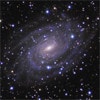Plan for ads in space

Orion, the Big Dipper and Andromeda could be joined in the heavens by ads for soft drinks and cigarettes if a Russian inventor's device catches on.
Alexander Lavrynov, a spacecraft designer, said he has patented a device for putting advertising into space that would be seen from Earth, Interfax news agency reported today.
"Space commercials could embrace huge areas and a colossal number of consumers," he said. "This would literally be intercontinental coverage."
The satellites would be visible in the night sky by employing sunlight reflectors, with multiple satellites linked together to create a message large enough to be seen.
"People would be able to see writing in the skies from the Earth no worse than they see the stars," he said.
Hubble Captures a Starry Night

Vincent Van Gogh saw the night sky as nobody else did -- until now. New images from the Hubble Space Telescope show an expanding swirl of illuminated interstellar dust reminiscent of the painterly skyscape of Van Gogh's "Starry Night."
The images captured in early February depict a distant red giant star called V838 Monocerotis, located about 20,000 light-years from Earth. The star gave off a pulse of light that illuminated a turbulent cloud of dust and gas, says NASA, revealing the swirls and eddies shown in the pictures at left.
While V838 Monocerotis is similar to a nova in many ways, it is unique among observed stellar objects for its behavior and its intense red color, according to the space agency.
The expanding light from the star will continue to illuminate more distant dust clouds, changing their appearance as it does. The object will be visible at least through 2010, say astronomers.
The Galaxy's Largest Diamond

When choosing a Valentine's Day gift for a wife or girlfriend, you can't go wrong with diamonds. If you really want to impress your favorite lady this Valentine's Day, get her the galaxy's largest diamond. But you'd better carry a deep wallet, because this 10 billion trillion trillion carat monster has a cost that's literally astronomical!
The newly discovered cosmic diamond is a chunk of crystallized carbon 50 light-years from the Earth in the constellation Centaurus. (A light-year is the distance light travels in a year, or about 6 trillion miles.) It is 2,500 miles across and weighs 5 million trillion trillion pounds, which translates to approximately 10 billion trillion trillion carats, or a one followed by 34 zeros.
The huge cosmic gem (technically known as BPM 37093) is actually a crystallized white dwarf. A white dwarf is the hot core of a star, left over after the star uses up its nuclear fuel and dies. It is made mostly of carbon and is coated by a thin layer of hydrogen and helium gases.
What does a Martian look like?

Fictional aliens come in all shapes and sizes - but what would a creature from another planet really look like? Would we even recognise one if we met it? In a new book published this month, science fiction writers Jack Cohen and Ian Stewart set out to find the answers.
The first thing to get straight when thinking about life on other planets, according to Jack Cohen, is that it will almost certainly not be humanoid.
"We've got to get away from all those comfortable ideas that aliens will be just like us, except for a few minor differences that don't challenge our imagination."
"They might look exactly like people. Or cats. Or houseflies. Or they could be invisible, or lurking just outside our space time continuum."
Bush Outlines Plan for 2015 Moon Landing

WASHINGTON Jan. 14 — President Bush beckoned the nation "forward into the universe" on Wednesday, outlining a costly new effort to return Americans to the moon as early as 2015 and use it as a waystation to Mars and beyond.
Bush said he envisioned "a new foothold on the moon...and new journeys to the world beyond our own," underscoring a renewed commitment to manned spaceflight less than a year after the loss of the space shuttle Columbia and a crew of seven.
One tenth of stars may support life

One tenth of the stars in our galaxy might provide the right conditions to support complex life, according to a new analysis by Australian researchers. And most of these stars are on average one billion years older than the Sun, allowing much more time, in theory, for any life to evolve.
The concept of a "galactic habitable zone" (GHZ) for the Milky Way was first proposed in 2001. Now Charles Lineweaver of the University of New South Wales and colleagues have defined a life-friendly GHZ using a detailed model of the evolution of the Milky Way to map the distribution in space and time of four major factors thought essential for complex life.
"We're looking at what we think are the most robust and conservative pre-requisites for life - but they are very, very basic," Lineweaver says.
Earth changes its spin, baffles scientists

BOULDER, Colorado (AP) -- In a phenomenon that has scientists puzzled, the Earth is right on schedule for a fifth straight year.
At the National Institute for Science and Technology in Boulder, spokesman Fred McGehan said most scientists agree the Earth's orbit around the sun has been gradually slowing for millennia. But he said they don't have a good explanation for why it's suddenly on schedule.
The leap second was an unexpected consequence of the 1955 invention of the atomic clock, which use the electromagnetic radiation emanated by Cesium atoms to measure time. It is extremely reliable.